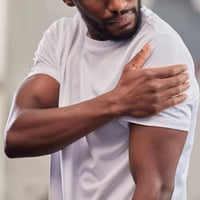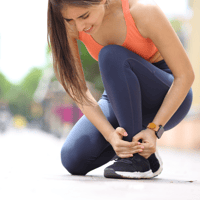A rotator cuff strain is a common shoulder injury that can cause pain, weakness, and limited...
What Is A SLAP Tear? Physical Therapy Recovery Tips

A SLAP tear (Superior Labrum Anterior to Posterior) is a common shoulder injury affecting the labrum, the cartilage ring that stabilizes the ball-and-socket joint of the shoulder. SLAP tears can cause pain, weakness, and instability, making it difficult to perform everyday movements and sports activities.
If left untreated, a SLAP tear can worsen over time, increasing the risk of shoulder dysfunction and further injury. Fortunately, physical therapy, strength training, and proper movement modifications can help many individuals recover without surgery. Below, we’ll explore the causes, symptoms, and expert-backed recovery strategies, including how physical therapy in NYC can help you regain strength and mobility.
What Is a SLAP Tear?
A SLAP tear refers to damage to the top part of the labrum, which helps keep the shoulder joint stable. The injury can occur due to repetitive overhead movements, acute trauma, or gradual wear and tear.
Common Causes of SLAP Tears
- Repetitive Overhead Movements – Common in athletes who perform repeated throwing, swimming, or weightlifting motions.
- Acute Trauma or Falls – Falling on an outstretched arm or a direct impact to the shoulder can tear the labrum.
- Heavy Lifting or Sudden Shoulder Movements – Lifting heavy objects with improper form can strain the shoulder joint.
- Age-Related Degeneration – The labrum naturally weakens over time, making older individuals more susceptible to SLAP tears.
Recognizing Symptoms of a SLAP Tear
SLAP tear symptoms often mimic rotator cuff injuries and other shoulder issues, making diagnosis essential. Common symptoms include:
- Deep shoulder pain, especially with overhead movements
- Clicking, popping, or grinding sensations during arm rotation
- Weakness and instability, making it difficult to lift objects
- Limited range of motion, particularly when reaching behind the back
- Pain when sleeping on the affected shoulder
For a comprehensive overview of symptoms, check out Cleveland Clinic’s guide to SLAP tears.
How Can Physical Therapy Help?
If you’re searching for physical therapy near you to recover from a SLAP tear, working with a shoulder rehabilitation specialist in NYC can help restore mobility, rebuild strength, and prevent further injury.
1. Shoulder Stability & Rotator Cuff Strengthening
- Isometric exercises to activate the rotator cuff and scapular stabilizers.
- Resistance band external rotations to improve shoulder endurance.
2. Manual Therapy & Joint Mobilization
- Hands-on techniques to increase shoulder mobility and reduce stiffness.
- Soft tissue work and stretching to relieve muscle tension around the joint.
3. Postural & Movement Corrections
- Adjusting shoulder blade positioning and posture to avoid impingement.
- Teaching proper lifting and throwing mechanics to reduce strain on the labrum.
4. Gradual Return to Activity & Sports-Specific Rehab
- Controlled plyometric drills for throwing athletes.
- Functional strengthening with closed-chain exercises to restore stability under load.
Surgical vs. Non-Surgical Recovery Paths
Not all SLAP tears require surgery. The treatment approach depends on tear severity, activity level, and functional demands.
Non-Surgical Recovery (Conservative Management)
- Recommended for minor to moderate SLAP tears.
- Focuses on physical therapy, strengthening, and gradual activity progression.
Surgical Repair (When Necessary)
- SLAP Repair Surgery: The labrum is sutured back into place to restore stability.
- Biceps Tenodesis: Used when biceps tendon involvement worsens symptoms.
- Recovery Timeline: Most patients return to full activity within 4-6 months.
At-Home Strategies for a Speedy Recovery
Alongside physical therapy in NYC, the following strategies can help manage symptoms and prevent further injury.
1. Avoid Overhead Strain & Heavy Lifting
- Modify daily activities to avoid placing excessive stress on the shoulder joint.
- Use proper form when lifting or reaching overhead.
2. Use Ice & Heat Therapy
- Apply ice for 15-20 minutes post-activity to reduce swelling.
- Heat therapy before stretching can help loosen tight muscles.
3. Strengthen the Shoulder & Core
- A strong rotator cuff and scapular stabilizers help reduce strain on the labrum.
- Core training improves overall shoulder stability and movement efficiency.
4. Focus on Shoulder Mobility & Posture
- Gentle stretching can help restore shoulder flexibility and pain-free motion.
- Avoid prolonged forward head posture or slouching, which can aggravate symptoms.
When to See a Doctor or Physical Therapist
If shoulder pain, instability, or weakness persists beyond a few weeks, worsens over time, or affects sports performance, seeking professional care is essential. A doctor may recommend imaging tests like MRI or CT scans to confirm the diagnosis.
A physical therapy place near you specializing in shoulder rehabilitation and sports therapy can provide a structured recovery program to restore strength and prevent long-term issues.
Final Thoughts
SLAP tears can be painful and limiting, but with the right treatment from a specialized physical therapist —you can fully recover and return to your activities safely. If you’re looking for a physical therapist in NYC, find and book your PT now on MotionSync to recover and get back to doing what you love!
For more expert insights on shoulder health and injury prevention, explore our blog for the latest on physical therapy, sports recovery, and movement optimization.




